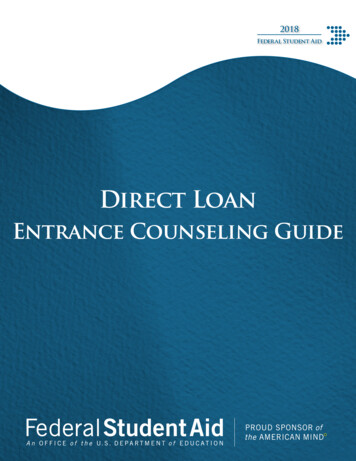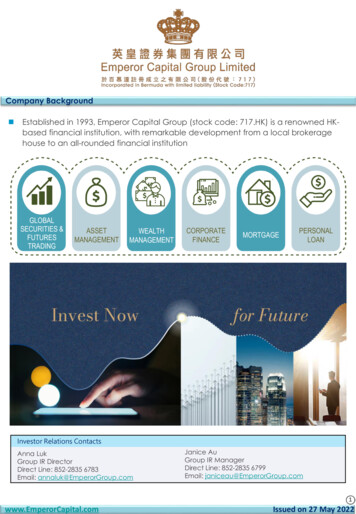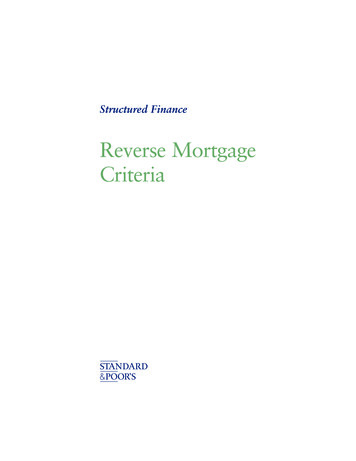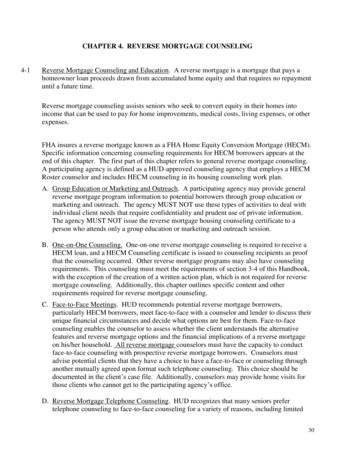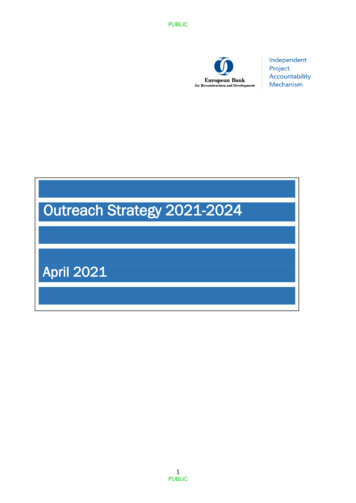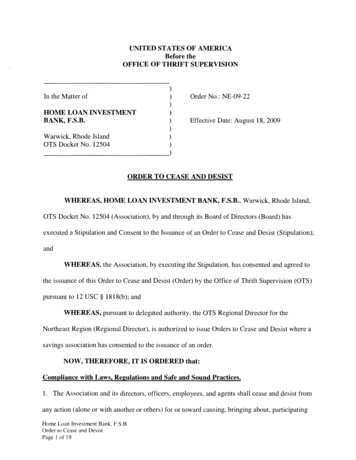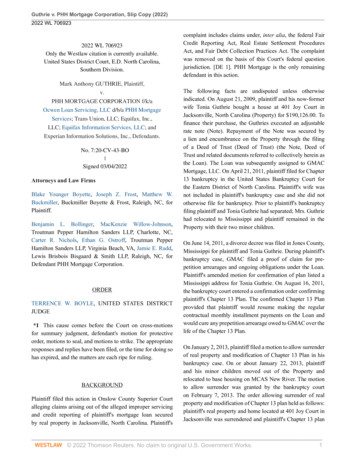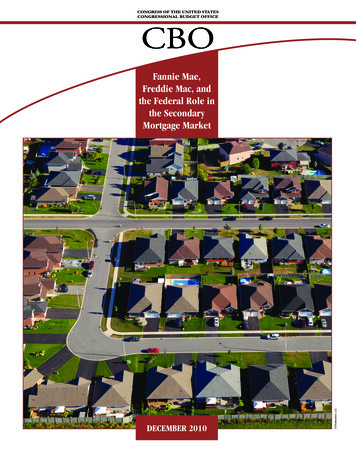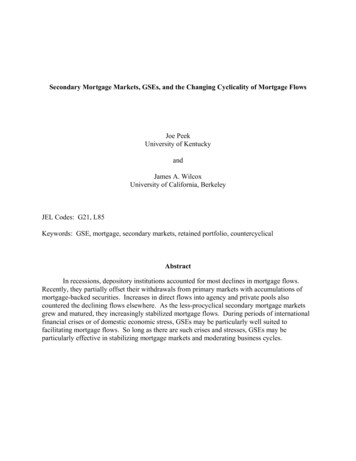
Transcription
EBRD Mortgage Loan MinimumStandards ManualUpdated June 2011
TABLE OF CONTENTSACKNOWLEDGEMENTS.IIINTRODUCTION.31. . LENDING CRITERIA (MS 01).42. . MORTGAGE DOCUMENTATION (MS 02).133. . MORTGAGE PROCESS AND BUSINESS OPERATIONS (MS 03).174. . PROPERTY VALUATION (MS 04).215. . PROPERTY OWNERSHIP AND LEGAL ENVIRONMENT (MS 05).266. . INSURANCE (MS 06).297. . CREDIT AND RISK MANAGEMENT STANDARDS (MS 07)338. . DISCLOSURES (MS 08).429.BASEL II AND III REQUIREMENTS (MS09).4310.SECURITY REQUIREMENTS.5011. .MANAGEMENT INFORMATION, IT & ACCOUNT MANAGEMENT (MS 11).52APPENDICESA1.LOAN APPLICATION FORMA2.LOAN APPROVAL OFFER LETTERA3.UNDERSTANDING SECURITISATIONA4.INVESTOR / RATING AGENCY SAMPLE REPORTMORTGAGE-BACKED SECURITYRESIDENTIALA5.INVESTOR / RATING AGENCY SAMPLE REPORTBONDCOVERED MORTGAGEA6.BIBLIOGRAPHYA7.GLOSSARYA8.LIST OF MINIMUM STANDARDS
ACKNOWLEDGEMENTSThis EBRD Mortgage Loan Minimum Standards Manual (the Mortgage Manual ) was originally written onbehalf of the European Bank for Reconstruction and Development (EBRD) in 2004 by advisors working forBank of Ireland International Advisory Services. It was updated in 2007. In June 2011, ShoreBank InternationalLtd. (SBI) updated further the Manual, which was funded by the EBRD - Financial Institutions Business Group.The 2011 List of Minimum Standards ( LMS ) provides guidance for those lending institutions that will receivemortgage financing from EBRD. This was produced based on the EBRD Minimum Standards and Best PracticeJuly 2007 outlined in the Mortgage Loan Minimum Standards Manual.In addition to supporting the primary market, the application of these guidelines should also ensure that themortgage loans will meet requirements for the possible future issuance of Mortgage Bond ( MB ) or MortgageBacked Securities ( MBS ). For a mortgage portfolio to be considered suitable for inclusion in an MB or MBS,the lending institution must be aware of the prospective requirements of both credit rating agencies andinvestors.We wish to thank the following for their insights and contributions:Alexander Tanase (who was the Operation Leader), Andreea Moraru and Sibel Beadle, all from theEBRD Financial Institutions Group. Frederique Dahan from OGC also provided very useful comments;Olga Gekht, Daniel Kolter and Maria Serrano of Moody s Investors Service, Inc.; andSBI Team Pamela Hedstrom, Mitchel Medigovich, Ira Peppercorn, Lauren Moser Counts, AlanMartinez, Anna Fogel and Georgiana Balanescu.We also appreciate comments and suggestions from mortgage professionals at Banca Comerciala Romana(BCR, part of Erste Group) and Banca Transilvania, which have been clients of previous EBRD mortgagelending programs.Mortgage Loan Minimum Standards ManualJune 2011ii
INTRODUCTIONThis EBRD Mortgage Manual has been written based on the EBRD List of the Minimum Standards and BestPractices - June 2011. This is the third edition outlined in the List of Mortgage Lending Standards to provideguidance for those lending institutions that will receive mortgage financing from EBRD. All partner banks andnon-bank financial institutions receiving mortgage credit lines from EBRD should comply with the List ofMinimum Standards and Best Practices to ensure that, as much as possible, the mortgages underwritten usingEBRD funds are originated and managed in a prudent manner. In addition to supporting the primary market, theapplication of these guidelines should also ensure that the mortgage loans will meet requirements for thepossible future issuance of Mortgage Bond (MB) or Mortgage-Backed Securities (MBS). For a mortgageportfolio to be considered suitable for inclusion in an MB or MBS, the lending institution must be aware of theprospective requirements of both credit rating agencies and investors. The application of these minimumstandards and best practices is appropriate for the ongoing management of both the primary and secondarymortgage business.This Manual should provide further explanation for each standard or best practice, as required, in the LMS. TheLMS and Manual were updated in June 2011 and contain recommendations and information based on researchundertaken by the EBRD and its consultants. It is not intended to be definitive. Further improvements tomortgage lending practices will be identified as the partner banks and non-bank financial institutions furtherdevelop this business and this document may be updated from time to time.Funds used for mortgages not only create a benefit for the financial institutions and the borrowers, they impactmany other industries from construction to insurance and to appliances, just to name a few. Historically, priorto enlargement and the 2008 global financial crisis, the mortgage market in Europe expanded at a rate of 8percent per annum and accounted for 40 percent of GDP. However, in 2009 the mortgage market in the 27country EU grew at only 0.6% reaching EUR 6.1 trillion.1The financial crisis demonstrated how important it is to stay with the basic principles of mortgage lending andnot to assume that the trend is always upward. The trends to originate mortgages with lower and lower downpayments, with foreign denominated mortgages and with interest rates that adjusted beyond a borrower s meansshow what can happen when these basic principles are not followed.The Manual consists of the following chapters:1.2.3.4.5.6.7.8.9.10.11.Product and Lending Criteria (MS O1)Mortgage Documentation (MS O2)The Structure of a Mortgage Business Operation (MS 03)Property Valuation (MS 04)Property Ownership (MS 05)Insurance (MS 06)Credit and Risk Management Standards (MS 07)Disclosures (MS 08)Basel II and III Requirements (MS 09)Security Requirements (MS 10)Management Information, IT and Account Management (MS 11)Within most of these chapters, the document outlines the List of the Minimum Standards, Best Practices, andReasons for Minimum Standards/Best Practices, possible Investor/Rating Agency Issues and further Points toNote are included (see Appendix A8). Further operational information and details are included in the otherAppendices.1European Mortgage Federation, www.hypo.orgMortgage Loan Minimum Standards ManualJune 20113
1. LENDING CRITERIA (MS 01)1.1Minimum StandardsEBRD has adopted specific lending criteria for local currency and foreign currency mortgage loans to provideguidance for those lending institutions that have received mortgage financing from EBRD. All partner banksand financial institutions should comply with the Minimum Standards and Best Practices to ensure that themortgages underwritten using EBRD funds are originated and managed in a prudent manner.All mortgage products should have certain characteristics. Differentiated standards apply to local currency andforeign currency mortgages. This approach is designed to tighten standards on FX loans relative to local currencyloans, to create a buffer against devaluation risk. There may be country cases in which macroeconomic volatilityis such that a bias towards local currency mortgages would not be appropriate. In those cases, the standards willbe adjusted as necessary.MINIMUM STANDARDS COMMON FEATURESMinimum StandardsMS 01: The following features should be observed for all types of mortgage products:Purpose:Residential properties - purchase, remortgage, build orimprove, including the relevant land, if any principal privatedwelling or "buy-to-let" houses or apartments.Product Type:Constant annuity mortgage only, with full amortisation toliquidate the debt by the end of the mortgage term.Property location:Within the country of the lender.Borrower:Nationals and non-nationals resident in the country. Nationalsand non-nationals resident outside the country purchasingwithin the country.Amount:Minimum/maximum amount stated - 250,000 Euro equivalentin local currency.Loan Term:Minimum 5 years/maximum 30 years (subject to funding).Borrower Age:Minimum age of legal contract. Maximum (at completion ofthe mortgage loan term): legal retirement age, as regulated inthe respective country, unless demonstrable evidence ofsufficient pension and/or other income to support mortgagepayments up to the end of contracted mortgage.Interest Rate:Interest Rate: Variable or Fixed. Fixed interest rates arepreferable. If they are not available in the country or if theborrowers opt for variables rates, the lender shouldappropriately inform the borrowers about the risks involved.Teaser rates are not allowed. Interest rate switching from fixedto variable (or vice-versa) are allowed, but in such cases theborrower must be notified in writing (at least 3 months inadvance) and should the borrower choose to pre-pay, theprepayment fee should be waived.Variable Rate Mortgages (VRM). Where the interest ratecharged to the customer is variable, it should be linked(indexed) to the relevant reference rate for the loan currency(e.g. Libor, Euribor, etc.) and contain a margin for profit. Theindex should ideally be equitable and independent:Reasonable efforts should be undertaken by lenders tolink to external indexes, such as those published byCentral Banks;When this is not possible, lenders can use internalindexes, but these should be published regularly.Mortgage Loan Minimum Standards ManualJune 20114
Property ValuationShould be carried according to Section 4. The LTV limit is toapply to the lower of either the actual purchase price or thevaluer s estimation. In the event that the purchase price ishigher than the valuer's estimation the lender should lend onthe lesser of these two figures.Tenure of Property:Full ownership. Freehold recommended. Leasehold withminimum of 50 years after the maturity of the loan or legalmaximum, if lower (see MS 05).Security Required:First rank mortgage over the property. Assigned life insurancefor the amount and term of the mortgage. Property insurancein the joint names of the lender and customer to cover thereinstatement cost of the property. This policy to be indexlinked, if available.Verification:Supporting documents as listed in MS 02.MINIMUM STANDARDS LOCAL CURRENCY MORTGAGE LOANSMinimum StandardsMS 01: The lender must adopt the following criteria for local currency mortgage loansCurrency:Local currencies onlyLoan to Value:Maximum 80% LTV for owner-occupiedMaximum 70% for buy-to-let .PTI:Up to 50% of borrower s net income for owner-occupiedproperties. Maximum 35% of borrower s net income for buyto-let (For mortgage with higher incomes, lenders may usethe maximum rate, but within the limits of the procedures andprudential requirements of the Central Bank).Affordability Test:Use of Net Disposable Income (NDI), Debt Service Ratio(DSR) model or Payment-to-Income (PTI). This model shouldstress test the customer s ability to repay by adjusting theinterest rate upwards, usually by 3% (300 basis points). Themodel should have a floor limit of funds available for livingexpenses.properties.BEST PRACTICES LOCAL CURRENCY LOANSBest PracticesBP 01Local Currency Mortgage Loansi. Lenders should also consider introducing geographic and employerdiversification parameters to avoid concentration risk by setting limits on thepercentage of the portfolio that can be in a particular location or loaned tostaff of a particular employer. The level of geographic diversification willdepend on city size and population.ii. For local currency loans maximum 80% LTV unless supported by a mortgageindemnity guarantee to be exercised in a prudent manner (taking into accountthe repayment capacity of the mortgagees) and with creditworthy insurers.iii. PTI or DSR: Prudential regulations should be applied.Mortgage Loan Minimum Standards ManualJune 20115
MINIMUM STANDARDS FOREIGN CURRENCY LOANSMinimum StandardsMS 01: The lender must adopt the following criteria for foreign currency mortgage loans:Currency:Euro and USD currencies only.Loan to Value:Dependent on lender Credit Policy maximum 70% LTV forowner-occupied properties. Maximum 60% for buy-to-let .PTI:Up to 35% of net income for owner-occupied properties.Maximum 30% of net income for buy-to-let (for mortgagewith higher incomes, lenders may use the maximum ratewithin the limits of their procedures and prudentialrequirements of the Central Bank).Affordability Test:Same as for mortgage loans denominated in Local Currencies.In addition, this model should test the customer s ability torepay in case of depreciation of the local currency (it isrecommended that various degrees of depreciation are tested).BEST PRACTICES FOREIGN CURRENCY LOANSBest PracticesBP 01Foreign Currency Mortgage Loansi. For hard currency or forex loans maximum 70% LTV unless supported by amortgage indemnity guarantee to be exercised in a prudent manner (takinginto account the repayment capacity of the mortgagees) and with creditworthyinsurers.ii. Forex loans should be given to individuals whose revenue is in Forex orForex-linked.Underwriting Criteria is the practical application of the lender s Credit Policy and the key aspect is to establishthe applicants ability to repay the loan.In addition to supporting the primary market, the application of these lending criteria will also ensure that themortgage loans will meet requirements for the possible future issuance of Mortgage Bond (MB) or MortgageBacked Securities (MBS). For a mortgage portfolio to be considered suitable for inclusion in an MB or MBS, thelending institution must be aware of the prospective requirements of both credit rating agencies and investors.FURTHER READINGRefer to Appendices A4 and A5 for examples of Residential Mortgage-Backed Securities and Covered MortgageBond issues.1.2Establishing Interest RatesThe credit committee and treasury must have a working relationship to establish interest rates for various loan products.The interest rate charged to customers should be adequate to cover the bank's cost of funds plus a suitable margin forprofit and operating expenses. Where the interest rate charged to the customer is variable, it should be linked to therelevant reference rate for the loan currency (e.g. Libor, Euribor, etc.). The index should be equitable and, if possible,independent.An organisation establishes interest rates on several factors; the most important of which is the Cost of Funds.Mortgage Loan Minimum Standards ManualJune 20116
When establishing an interest rate for a fixed rate loan, the lender must also consider the matter of a matchingmaturity. For example, if the lender is a bank and the bank is funding loans from deposits, the average term of aloan should be matched to similar time periods for long term deposits. In circumstances where long termdeposits are not customary or available, the bank should consider a hybrid product that has a fixed rate for aspecified period of time, and later converts to a variable rate.Variable interest rates have two components which, when added together result in the interest rate the borrowerwill pay for a specific period of time.The components are the cost of funds index, such as an inter-bank offered rate (IBOR) and the margin for profitand overhead.For example:Index IBORMarginInterest rate4.5%2.5%7.0%The period during which the interest rate is set at 7% is 3 years, then adjusting each one to three years thereafterfor 20 years.The borrowers rate changes in line with changes in the market benchmark. The precise mechanics can vary bylender or country. For example a 'tracker mortgage' usually defines the precise time response for upward anddownward movements to the IBOR rate and may guarantee a maximum deviation from this rate.With regard to Residential Mortgage-Backed Securities (RMBS), these transactions are usually structured so thatthe interest to bond holders is struck at IBOR plus a premium expressed in basis points. This might be 1 month or3 month IBOR plus 50 basis points. Clearly if the underlying mortgages that are securitised are all variableinterest rates it makes sense to have these rates adjustable in similar fashion. Some of the structures might havea fixed interest rate at the outset.Often with Mortgage Bonds, the interest rate on the underlying bonds may be fixed for a specified duration orthey might be variable. Some countries have preferences for fixed rates - such as Germany - whereas the UK andIreland see many customers with variable rate mortgages.Both RMBS and Mortgage Bonds therefore require considerable care and attention as to how underlyingmortgages are priced and then how the underlying interest rates can be changed. This potentially can affect theability for product flexibility and profitability.The mechanics of dealing with duration risk and interest rate risk are beyond the scope of this Mortgage Manual.1.3Mortgage Sales ChannelsLoan Origination may be carried out through several channels including direct contact, mail, e-mail, SMS text,telephone and other acceptable banking channels.Loan officers can execute marketing campaigns through several methods the first and most effective of which isdirect contact with a prospective borrower. A loan kiosk or desk located in an existing branch of a bank is mostconvenient. Often, banks will develop loan centres with physical locations outside of the bank. Loan centres canbe easier to access and less intimidating to prospective borrowers and can accommodate amenities such as aplay room for young children while the parents participate in the loan process.Other but less effective methods of soliciting prospective borrowers is through mail, SMS text and telephone.Typically direct mail has the lowest response rate of 1-2 percent; therefore the campaign must be well designedand targeted to areas where home buyers are most likely to be found, such as apartment houses or flats.Mortgage Loan Minimum Standards ManualJune 20117
Another successful method of loan origination is through wholesale operations. The lender may engage inpurchase agreements with loan originations from third party companies such as affiliates or brokers. In thismethod the third party takes the application, coordinates the appraisal and title search and often obtainsverification of income, employment, assets and liabilities. Wholesale lending operations require the allocation ofgreater resources to verify and validate the information provided from third party originators.Wholesale loan operations require a well-designed fraud prevention program that addresses methods of fraud,identification of schemes and which parties to the transaction might present the greatest risk of fraud.1.4Mortgage Market SegmentsOnce the organisational structure is determined, the Credit Committee and senior management of theorganisation must then consider the market segment it wishes to pursue. Each segment has unique requirementsand borrower characteristics that should be reviewed for compatibility to the culture as well as the investmentobjectives of the organisation.After the organisation determines its target market, the selection of mortgage products that will be sold must beconsidered. The following chart identifies the transaction type, its unique characteristic and suggested actions totake for managing the type of clients.Table 1. Target market characteristics and actionsTransaction TypeUnique CharacteristicSuggested ActionsPurchaseFirst time home buyerThe borrower will have noexperience with the process orknowledge of the responsibilities ofhome ownership.Use loan officers, underwriters andcloserswhoarecurrenthomeowners. A mature loancloser/attorney is best suited totake the time necessary to help thefirsttimebuyerbecomecomfortable. Most first time homebuyers will need to have each stepand each term explained. Take careto define terminology used and tryto avoid jargon when describingterms and covenants in the loanagreements.PurchaseMove upSecond homerelocation buyerThis borrower has been through theprocess and generally does notrequire the same amount ofattention as the first time homebuyer.Be sensitive to the amount of timeyou are requiring of the move upbuyer. Most will not need detailedexplanation of every detail of thetransaction.RefinanceExisting home ownerThe objectives of this buyer shouldbe clearly identified. In most cases,they are refinancing to lower debtand/or lower payments.Quickly identify the benefits thatthe borrower will realised when thetransaction is complete. If thebenefit is not obvious, investigatefurther the borrower s objectives.Home EquityThe borrower s objective is toutilise equity that has beenThe lender should inquire as to theborrower s intended use of theMortgage Loan Minimum Standards ManualJune 20118
accumulated over a period of years.Typically the borrower will have apredetermined use of the funds.Self-BuildOrOwner-Builder Projects1.5Self- build projects are the highestrisk loan for a mortgage lendingorganisation. Often the loan is basedon the projected cost of materialsand some labour. Typically theborrower intends to provide most ofthe labour themselves. Risksinclude poor workmanship, failureto complete the project or delays inconstruction. See more on SelfBuild projects in Chapter 6.funds and look for opportunities tosell the borrower other bankproducts; this is known as crossselling.The lender should require theborrower to provide a constructionbudget with the type and grade ofmaterial to be used. The lendershould verify the costs and advancethe loan funds incrementally onlyafter verification of the workcomplete.Product TypesThe chart below illustrates the type of mortgage loans that are typically offered to home buyers and those whocurrently own a home. Loan products should be carefully matched to the objectives of the borrower and theavailability of funds. See more about matching funds in the discussion on interest rates.Table 2. Mortgage productsProduct TypeFeaturesOptimum BorrowerLien RankFixed RatePredictable Principal and Interest payment whichcan be amortised for periods of 5, 10, 15, 20 and25 years.First time home buyers,families and borrowers onfixed income.First RankVariable Rate(VRM)The interest rate is tied to a well-known indexand includes a margin in addition to the indexrate. Payments may change each 1, 3 or 5 yearsbased upon the agreement of the lender andborrower. Most VRM loans have a lower initialrate of interest than fixed rate loans. The loanmay be amortised or interest only for an initialperiod (say 3 years) and then amortised over theremaining term of the loan.Typically, high incomeborrowersoryoungprofessionals who expecttheir income to increase inthe coming years.First Rank,or on anexceptionalbasis if theloan is ahomeequityloan,secondrank.Interest OnlyLoansMonthly payments are calculated on the basis ofthe unpaid principal balance at the note rate. Thistype of loan requires the borrower to make asingle payment, also known as a balloonpayment at a predetermined date.This product is best suitedfor self-build loans, or loansfor short term mine their ability repaythe balloon payment.First RankHomeRenovationand EnergyEfficiencyLoansMonthly payments should be structured asprincipal and interest payments over a period of5, 10 or 15 years. Before issuing the loan thelender should evaluate the cost of theimprovements and the potential benefits to theborrower. There are cases where improvementsto a property will extend the economic life of ahouse which may be beneficial to the borrower.Owners of homes and flatsmore than 10 years old.First RankMortgage Loan Minimum Standards ManualJune 20119
Self-Build andOwner BuilderProjects1.6The principal of the loan is disbursed in draws ona predetermined loan amount based on work thathas been complete. Owner-builder loans areshort term, 1-3 years which requires the borrowerto pay off the loan or seek long term financing.The loan should require interest only paymentson the amount of the unpaid principal balance.An experienced craftsmanis optimum; however, aborrower who has tradeskills generally makes areasonable risk.First RankSelf Build ProjectsWhen a customer owns the land and wishes to construct a home, the construction may be carried out by either a'registered builder' or by 'direct labour , also known as Owner-Builder. In many countries, the constructionindustry, with Government approval and support has set up a scheme which provides guarantees on the qualityof construction of houses. We have examined this scheme in more detail under Insurance in Chapter 6. Once thescheme is set up, builders are anxious to join because buyers naturally try to purchase properties where thestandard of construction is guaranteed.Construction lending presents the greatest risks to a lender. The risk of development should be reflected in theinterest rate charged. Critical to the security of the loan is the manner in which the lender releases funds forconstruction of the project. There are two methods of construction management:i.ii.Phased drawdowns based on a percentage of the work, such as 20%, 20%, 20%, 10%, 10%, forexampleDrawdowns on the actual work or stages which have been completedRegardless of the method that a lender prefers to follow, all construction loans begin with the analysis of theconstruction budget. It is recommended that the lender retain an architect or engineer to carefully analyse thecost of labour, materials and land.In most cases the land should be paid in full by the borrower as their equity contribution, see the chart below.Thereafter, the loan should be analysed to identify the cost per square meter of the project and compare thecosts with similar projects in similar areas. Project costs may vary depending upon the type of construction,(wood vs. concrete), and the finish of the interior. In addition to hard costs such as bricks and labour,construction financing includes soft costs such as architectural and engineering fees, permits, insurance and loancosts. The lender must require course of construction' insurance to protect the lender and borrower in the eventof a catastrophic event while the project is being built.Analysis of risk of construction loans employs both the Loan to Value Ratio and the Loan to Cost Ratio. TheLoan to Value ratio is applied on the basis of the finished value of the property, while the Loan to Cost Ratioconsiders the total cost of the project, valued by components of land, material and labour and the loan amount.For example if the project being built is a stand-alone single family home on a residential plot of land thecomponents should be valued independently. The lender should then make the loan on the lower of the Loan toCost or Loan to Value.Table 3.Risk analysis of construction loansComponentsLandMaterialsLabourSoft CostsTotalActual Cost age Loan Minimum Standards ManualMaximum Loan toCost @ 80%12,500*36,00028,0008,40084,900June 2011Appraised ValueMaximum Loan toValue @75%145,000108,75010
*Some lenders will permit the borrower to contribute the value of the land as a portion of their equity in theproject. However, it is highly recommended that the value of the land contribution typically not exceed 50% ofthe cost of the land, depending on the country and actual location of the respective land.Registered Builder/Fixed Price contractIn all instances where a builder is employed the customer should ensure (and the lender should insist) that only afixed price contract is used. Such a contract will assure both the lender and borrower that price increases cannot bemade. It is important to note that in an expanding or emerging economy, fixed priced contracts may not be feasibleas materials and labour increase. In this case, the lender must approve any changes in the contract and/or theborrower must be prepared to pay for increased costs from their own resources unless the borrower s equity issubstantial enough to keep the Loan to Value at or below the requisite level.Direct Labour (Owner-Builder)Direct labour means that the borrower is either building the house himself/herself or is employing all the variousskills - bricklayers, plumber, electrician or other trades.Extra diligence is required to ensure that the budget is closely followed. An experience construction loanmanager should be retained to verify all costs incurred by the borrower.However suitable situations and opportunities will arise - e.g. customer is a building professional and hasprevious experience. Undoubtedly a well-managed 'self-build' project will cost the owner less than employing abuilder.Phased PaymentsBorrowers who chose to build a home require a mortgage in the same way as people purchasing a finishedhomes do. The difference is that the need the money in phases or stages.In many cases the borrower will have begun construction with their own funds first. From a lenders perspectivethis ensures commitment and equity contribution. The more of their own funds they use the less likely they areto default or to abandon the project. For example, if the total cost is 100k and the mortgage is 70k then thecustomer s contribution is 30k - these funds will be used before the lender will release the phased payments.The facility offers gradual drawdown of funds typically in tranches as the construction progresses. These areclearly defined completion points in the project and are:Stage 1: Site preparation and foundationStage 2: Framing - exterior walls and roof erected, windows framed and roughed inStage 3: Mechanical electrical, water, heating or cooling systems and insulationStage 4: Interior finishes such as plaster and paint appliedStage 5: Interior trim such as doors, faucets, toilets flooringStage 6: Exterior finishes, landscaping, onsite parkingAt each stage the lender requires inspection and certification by an architect or other suitably qualifiedprofessional (engineer or quantity surveyor) that the work has bee
This EBRD Mortgage Manual has been written based on the EBRD List of the Minimum Standards and Best Practices - June 2011. This is the third edition outlined in the List of Mortgage Lending Standards to provide guidance for those lending institutions that will receive mortgage financing from EBRD. All partner banks and
